Convair CV-240 family
| CV-240 family | |
|---|---|
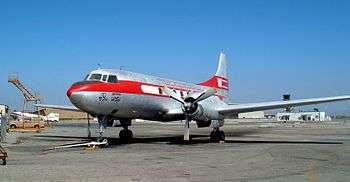 | |
| A restored Convair CV-240 in Western Air Lines livery, at the Planes of Fame Museum in Chino, California, USA | |
| Role | Airliner |
| Manufacturer | Convair |
| First flight | March 16, 1947[1] |
| Introduction | February 29, 1948 with American Airlines |
| Primary user | American Airlines[1] |
| Produced | 1947–1954[1] |
| Number built | 1,181[1] |
| Variants | Convair C-131 Samaritan Canadair CC-109 Cosmopolitan[1] |
The Convair CV-240 is an American airliner produced by Convair from 1947 to 1954, initially as a possible replacement of the ubiquitous Douglas DC-3. Featuring a more modern design with cabin pressurization, the 240 series was able to make some inroads as a commercial airliner and also had a long development cycle which resulted in various civil and military variants. Although reduced in numbers through attrition, the "Convairliners" in various forms continue to fly into the 21st century.[1]
Design and development
The design began its life in a requirement by American Airlines for an airliner to replace its Douglas DC-3s. Convair's original design, the unpressurised Model 110' was a twin-engine, low-wing monoplane of all-metal construction, with 30 seats. It was powered by Pratt & Whitney R-2800 Double Wasp radial engines and had a tricycle landing gear and a ventral airstair for passenger boarding.[2] The prototype Model 110, registration NX90653, first flew on July 8, 1946.[2] By this time, American had changed its requirements to require pressurization and deemed the design too small. The first prototype was used by Convair for development work for the 240 series before being broken up in 1947.[3]
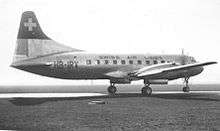
To meet the requirements of airlines for a pressurized airliner, Convair produced a revised design—the Model 240. This had a longer but thinner fuselage than the Model 110, accommodating 40 passengers in the first pressurized, twin-engined airliner.[4] The 240 first flew on March 16, 1947.[5]
The Model 240 was followed by the Model 340 that had a longer fuselage, longer-span wings and more powerful engines. The 340 first flew on October 5, 1951.[6] In 1954, in an attempt to compete with turboprop-powered airliners like the Vickers Viscount, Convair produced the Model 440 Metropolitan, with more streamlined cowlings, new engine exhausts, and better soundproofing for the cabin.[7] As the "Super 240" evolved into the CV-340 and CV-440, the limit of piston-engine performance was reached, and future development centered on conversion to turboprop power.[1]
Operational history
The first delivery of a production Convairliner was to American on February 29, 1948.[5] A total of 75 were delivered to American, with another 50 going to Western Airlines, Continental Airlines, Pan American Airways, KLM, Swissair, Sabena, and Trans Australia Airlines.[8]
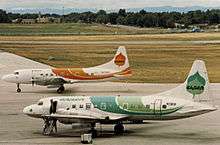
A CV-240 was the first private aircraft used in a United States presidential campaign. In 1960, John F. Kennedy used a CV-240 named Caroline (after his daughter) during his campaign. This aircraft is now preserved in the National Air and Space Museum.
After aborted negotiations with TWA and Eastern for "Super 240" orders, the production of the 240 series was temporarily halted. In response to a United inquiry, Convair redesigned the Super 240, calling it the CV-340. United ordered 55, and more US orders came from Braniff, Continental, Delta, Northeast and National. Other orders came from abroad, and the CV-340 proved popular in South America. The CV-340 earned an enviable reputation for reliability and profitability, and was developed into the CV-440 Metropolitan, the final piston-engined variant of the "Convairliners."[1]
Kelowna Flightcraft Air Charter, the major remaining operator of this model, currently holds the type certificate for this aircraft.
Used price for a Convair 240 in 1960 was around £40,000.[9]
Variants
Data from: General Dynamics Aircraft and their predecessors[1]
Civil variants
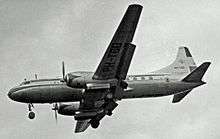

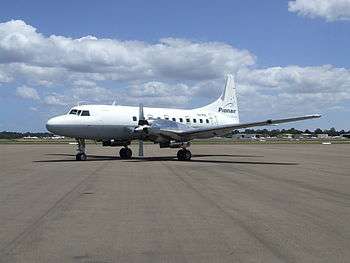

- Convair Model 110
- Unpressurized prototype with seats for 30 passengers. 89 ft (27.13 m) wingspan, 71 ft (21.64 m) length, powered by two 2,100 hp (1,567 kW) Pratt & Whitney R-2800-SC13G engines. One built.[2]
- Convair CV-240
- Initial production version. Powered by two Pratt & Whitney R-2800 engines.
- Convair CV-240-21 Turboliner
- Turboprop-powered conversion fitted with Allison T38 engines. It became the first turboprop airliner to fly in the United States (on December 29, 1950), but problems with the engines resulted in development being terminated and the prototype being converted back to piston power.
- Convair CV-300
- A conversion from a Convair CV-240 with two R-2800 CB-17 engines and nacelles as used on the CV-340.[10] In 1977, a CV-300 was involved in an accident that killed three members and the manager of the rock group Lynyrd Skynyrd.[11]
- Convair CV-340
- Built for United Airlines and other operators including KLM, the CV-340 was a CV-240 lengthened to hold an additional four seats. The wingspan was extended for better performance at higher altitudes. The CV-340 replaced the DC-3 in United service. The airline flew 52 340s for 16 years without a fatality. KLM operated the type from early 1953 until mid-1963. Many CV-340 aircraft were converted to CV-440 standard.[12]
- Convair CV-440 Metropolitan
- CV-340 with improved soundproofing and an option for weather radar. Maximum weight rose to 49,700 lbs. An optional increase from 44 to 52 passengers was facilitated by the replacement of the carry-on luggage area with two more rows of seats, marked by the addition of an extra cabin window. This option was taken up by several airlines including Swissair, Lufthansa and SAS.[12] Finnair operated the type from 1953 until 1980 without a single accident.
- Convair CV-540
- Conversion from a Convair CV-340 aircraft with two Napier Eland turboprop engines in place of the piston engines. Six aircraft were converted by Napier for Allegheny Airlines.[13] Cost for the conversions was £160,000 per-aircraft. 12 built as new-builds by Canadair for RCAF as CC-109 in 1960 for £436,000 per-aircraft. First flight February 9, 1955.[14]
- Convair CV-580
- Conversion from Convair CV-340 (Allison Prop-Jet Convair 340) or CV-440 aircraft with two Allison 501 D13D/H turboprop engines with four-blade propellers, in place of piston engines with three-blade propellers, an enlarged vertical fin and modified horizontal stabilizers. The conversions were performed by Pacific Airmotive on behalf of the Allison Engine Company.[13] Cost of the conversions was around £175,000 per aircraft and took 60 days.[9] The CV-580 served with the original Frontier Airlines (1950-1986) and North Central Airlines for many years and was also the first aircraft type operated by American Eagle on behalf of American Airlines in code sharing feeder service.
- Convair CV-580 Airtanker
- Firefighting airtanker conversions with retardant tanks and dropping systems.
- Convair CV-600
- Conversion from a Convair 240 aircraft with Rolls-Royce Dart turboprop engines with four-blade propellers, in place of piston engines with three-blade propellers. CV-600 conversions were performed by Convair.[13] The CV-600 first flew with Central Airlines on 30 November 1965 and also served with Trans-Texas Airways (TTa) and successor Texas International Airlines for many years. The CV-600 aircraft that flew with Air Metro Airways was configured as a 40-passenger airliner. In 2012 the last Convair CV-600 (Rhoades Aviation) went out of service.[15]
- Convair CV-640
- Conversion from a Convair CV-340 or -440 with Rolls-Royce Dart turboprop engines with four-blade propellers, in place of piston engines with three-blade propellers. The conversions were performed by Convair.[13] In 2012, a total of seven Convair CV-640 aircraft remain in airline service, with Rhoades Aviation (one) and C&M Airways (six).[15]
- Convair CV-5800
.jpg)
- Conversion from former US Navy C-131F Samaritans by Kelowna Flightcraft Ltd. (KF Aerospace since 2015) in Canada. The CV-5800 is a C-131F Samaritan stretched by 16 ft 7 in (29,18 m)[16] with the Samaritan's original tail unit rather than the enlarged tail of the CV-580. These conversions also have a new freight door, digital avionics with EFIS and Allison 501-D22G engines in place of the original R-2800 engines. The prototype of this conversion first flew on February 11, 1992; the type certificate was issued on December 11, 1993.[17] A total of six aircraft were converted (construction numbers 276 to 279, 309, 343) and mostly used by Contract Air Cargo (later IFL Group); one aircraft was operated by Air Freight NZ.[18][19]
- Allison Turbine ATF 580S Turbo Flagship
- Stretched Convairliner conversion.[20]
Military variants
- Convair C-131 Samaritan
- The CV-240/340/440 series was used by the United States Air Force for medical evacuation and VIP under this designation
- Convair T-29 trainer
- A trainer model of the C-131 was used to instruct navigators and radio operators
- Convair R4Y Samaritan
- The United States Navy used the Samaritan under this designation
- Canadair CC-109 Cosmopolitan
- Conversion from CV-440, with Napier Eland turboprops in place of the piston engines. The conversions were performed in Canada by Canadair. In Royal Canadian Air Force and later in Canadian Armed Forces service they were known as the CC-109 Cosmopolitan. All were re-engined in 1966 with Allison 501-D13 engines.
- Canadair CL-66
- Company designation for the CC-109 Eland powered variant
Operators
Civil operators
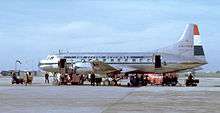
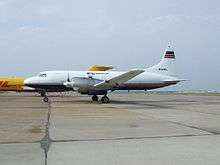


- This transport-related list is incomplete; you can help by expanding it.
Africa
- Air Algerie CV-640
- Ethiopian Air Lines - CV-240
- Kardair (Libya) CV-440
- Titan Helicopter Group (South Africa) - 3 CV 580
Asia
- Air Maldives - CV-440
- All Nippon Airways - CV-440
- Garuda Indonesia - CV-240, CV-340 & CV-440
- Iran Air- CV-240
- Japan Domestic Airlines - CV-240
- Orient Airways CV-240
- Pakistan International Airlines - CV-240
- Philippine Airlines - CV-340 (1950s–1960s)
- Saudi Arabian Airlines - CV-340
- Toa Airways
Australasia
- Air Chathams - CV-580 (current operator)
- Air Fiji - CV-580
- Air Freight NZ - CV-580 & CV-5800 (current operator)
- Ansett Airlines - CV-340, CV-440
- Chathams Pacific - CV-580
- Pionair - CV-580
- Real Tonga - CV-580
- Trans Australia Airlines - CV-240
Europe
- Aviaco - CV-440
- Alitalia - Linee Aeree Italiane - CV-240, CV-340 & CV-440
- Condor (& predecessor Deutsche Flugdienst) - CV-240 & CV-440
- Delta Air Transport - CV-440
- European Air Transport - CV-580
- Finnair CV-340 (converted to CV-440) & CV-440
- Fred Olsen Air Transport - CV-340[21]
- General Air (Germany) - CV-440
- JAT Yugoslav Airlines - CV-340 & CV-440
- Iberia Airlines - Convair CV-440
- Kar-Air CV-440
- KLM - CV-240 & CV-340
- Linjeflyg - CV-340 & CV-440
- LOT Polish Airlines - CV-240 (5 in 1957–1966)
- Lufthansa - CV-340 & CV-440
- Mey-Air - CV-240
- Nor-Fly Charter - CV-440 & CV-580
- Pan Adria CV-440
- Partnair - CV-580
- Polaris Air Transport - CV-240
- SABENA - CV-240 & CV-440
- SAS - CV-440
- SATA, SA de Transport Aérien - CV-440 & CV-640
- Stellar Airfreighter (Norway) - CV-440
- Swiftair - CV-580
- Swissair - CV-240 & CV-440
- Tellair - CV-440
United States and Canada
- Air Mid-America - CV-600
- Air New England - CV-580
- Air Rajneesh - CV-440
- Air Resorts - CV-440
- Air Tahoma - CV-240 & CV-580
- Allegheny Airlines - CV-340, CV-440, CV-540 & CV-580
- Alaska Airlines - CV-240
- American Airlines - CV-240
- American Eagle - See Metro Airlines
- American Inter-Island - CV-440 (wholly owned subsidiary of American Airlines which operated flights between San Juan, St. Thomas and St. Croix in the Caribbean)
- Aspen Airways - CV-240, CV-440 & CV-580
- Atlantic Gulf Airlines - CV-580
- Bar Harbor Airlines - CV-600
- Braniff International Airways - CV-340 & CV-440
- Buffalo Airways - CV-240 bought for its engines, not put in service
- Cal Sierra Airlines - CV-580
- Canadian Pacific Airlines - CV-240
- Caribair (Puerto Rico) - CV-340, CV-440 & CV-640
- Central Airlines - CV-240 & CV-600
- Cochise Airlines - CV-440
- Conair Group - CV-580
- Continental Airlines - CV-240 & CV-340
- Continental Express - CV-580 (operated by Trans-Colorado Airlines)
- Cordova Airlines - CV-240 (acquired by and merged into Alaska Airlines)
- Delta Air Lines - CV-340 & CV-440
- Desert Air - CV-240
- Eastern Air Lines - CV-440
- Era Aviation - CV-580
- Freedom Airlines - CV-580
- Frontier Airlines (1950-1986) - CV-240, CV-340, CV-440, CV-580 & CV-600 (CV-600 aircraft formerly operated by Central Airlines)
- Great Lakes Airlines (Canada) - CV-440 & CV-580
- Gulf Air Transport - CV-340, CV-440 & CV-580 (U.S. charter air carrier. CV-580 aircraft were formerly operated by North Central and Republic.)
- Harrison Airways (Canada) - CV-440
- Hawaiian Airlines - CV-340, CV-440 & CV-640
- IFL Group - CV-580 & CV-5800
- Kelowna Flightcraft Air Charter (KF Aerospace) - CV-580 & CV-5800
- Kitty Hawk Aircargo - Convair CV-240, CV-340, CV-440, CV-600 and CV-640
- L&J Company of Addison, Texas - CV-240 (aircraft tragically crashed with the band Lynyrd Skynyrd on board)[22]
- Lake Central Airlines - CV-340 & CV-580
- Laredo Air - CV-580
- Mackey Airlines (also known as Mackey International) - CV 440 & CV 580
- Metro Airlines (via its wholly owned Metroflight division) - CV-580 (former Frontier Airlines aircraft that were operated for American Eagle via agreement with American Airlines)
- Miami Air Lease - CV-440
- Midwest Air Charter/Airborne Express - CV-600
- Mohawk Airlines - CV-240 & CV-440
- National Airlines - CV-340 & CV-440
- Nolinor Aviation - CV-580
- Norcanair - CV-580 & CV-640
- North Central Airlines - CV-580
- Northeast Airlines - CV-240
- Northwest Airlines - CV-580 (former Republic Airlines aircraft that were previously operated by North Central Airlines)
- Pacific Western Airlines - CV-640
- Pan American World Airways (Pan Am) - CV-240 & CV-340
- Powell Air - CV-440
- Quebecair - CV-540 (CL-66)
- Renown Aviation - CV-440 & CV-580
- Republic Airlines - CV-580 (formerly operated by North Central Airlines)
- Resort Air Commuter - CV-580
- Rhoades Aviation - CV-640
- Sierra Pacific Airlines - CV-340, CV-440 & CV-580
- Skyfreighters - CV-440
- SMB Stage Lines - CV-600 & CV-640
- Summit Airlines - CV-580
- Sun Valley Key Airlines - CV-440 (U.S. commuter air carrier previously known as Sun Valley Airlines that operated out of Salt Lake City, UT and Sun Valley, ID which then changed its name back to Key Airlines)
- Trans-Texas Airways (TTa) - CV-240 & CV-600
- Texas International Airlines - CV-600 (former Trans-Texas Airways aircraft)
- Time Air - CV-580 & CV-640 (former Norcan Air and North Caribou, also one previously owned by Domino's Pizza)
- Trans-Colorado Airlines - CV-580 (aircraft painted in the livery of Continental Express)
- United Airlines - CV-340 & CV-580 (CV-580 aircraft operated via wet lease contract by Frontier Airlines (1950-1986) as the replacement for former United Douglas DC-6 service to Elko, NV and Ely, NV)
- Viking International Airlines - CV-600 & CV-640
- Westates Airlines - CV-580
- Western Airlines - CV-240
- Wright Airlines - CV-440, CV-600 & CV-640
- Zantop International Airlines - Convair 640
Mexico, the Caribbean, Central and South America
- Aero California - CV-340
- Aerolíneas Argentinas - CV-240 (LV-ADM, LV-ADN, LV-ADO, LV-ADP & LV-ADQ)
- Aerolineas Colonia (Uruguay) - CV-240
- Aeromexico - CV-340
- Aeroquetzal - CV-580
- ALM Antillean Airlines - CV-340 & CV-440
- ARCO Aerolíneas Colonia S.A. (Uruguay) - CV-240, CV-600
- Avensa - CV-340, CV-580, etc.
- Aviateca - CV-240, CV-340 & CV-440
- Caribair (Puerto Rico) - see North America
- Chilean Airways - CV-580
- COPA Compañia Panameña de Aviación - CV-340
- Cruzeiro do Sul - CV-240, CV-340 & CV-440
- LACSA - CV-440
- Líneas Aéreas Paraguayas (LAP) - 3 CV-240
- LAN Chile - CV-440
- Prinair - CV-580
- Real Transportes Aéreos - CV-340 & CV-440
- SAHSA - CV-580
- Transportes Aéreos Nacional - CV-440
- VARIG - CV-240, CV-340 & CV-440
Military operators
- Royal Australian Air Force - Two CV-440 Metropolitans (RAAF serial A95-313 and 353) were in service with RAAF from 1956 to 1968.[23]
- Transporte Aéreo Militar - Six CV-440s and five CV-580s acquired. One of each remaining as of 1987.[24]
- Royal Canadian Air Force and Canadian Armed Forces CV-540s were re engined with T56 turbo props with 412 Squadron
- Luftwaffe operated six CV-440s.
- Italian Air Force operated four CV-440 Metropolitans from 1957 until 1978[25]
- Paraguayan Air Force: CV-440/C-131D
- Sri Lanka Air Force - CV-440
- Mexican Air Force CV-580 Nowadays used as an AEW&C Simulator on AFB #1 Santa Lucia
Other operators
- Federal Aviation Administration[26]
- Airborne Resources, (C-131B N131CR[27])
- Environmental Research Institute of Michigan, later Veridian and then General Dynamics Advanced Information Systems (CV-580s N51211)[28] and N51255[29])
- Honeywell International, Everett Washington (CV-580 N580HW[30])
- Raytheon, Tucson Arizona (CV-580 N580HH[31])
- University of Washington, (CV-580 N3UW[32])
- National Research Council (Canada) (CV-580 C-FNRC[33])
- Canada Centre for Remote Sensing, later Environment Canada, retired to the Canada Aviation and Space Museum in June 2015 in recognition of its historical significance to Canadian science (CV-580 C-GRSC[34])
Accidents and incidents
Specifications (CV-240)
Data from General Dynamics Aircraft and their Predecessors[35]
General characteristics
- Crew: 2 or 3 flight deck crew
- Capacity: 40
- Length: 74 ft 8 in (22.76 m)
- Wingspan: 91 ft 9 in (27.97 m)
- Height: 26 ft 11 in (8.20 m)
- Wing area: 817 sq ft (75.9 m2)
- Empty weight: 25,445 lb (11,542 kg) (revised 29,500 lb (13,381 kg))
- Gross weight: 40,500 lb (18,370 kg) (revised 42,500 lb (19,278 kg))
- Fuel capacity: 1,000 US gal (3,785.41 l) - 1,550 US gal (5,867.39 l)
- Powerplant: 2 × Pratt & Whitney R-2800-CA3 Double Wasp / CA15 / CA18 / CB3 or CB16 18-cyl air-cooled radial engines, 2,400 hp (1,800 kW) each
- Propellers: 3-bladed Hamilton Standard or Curtiss
Performance
- Maximum speed: 315 mph (507 km/h; 274 kn)
- Cruise speed: 280 mph (243 kn; 451 km/h) (maximum)
- Range: 1,200 mi (1,043 nmi; 1,931 km)
- Service ceiling: 16,000 ft (4,877 m)
- Rate of climb: 1,520 ft/min (7.7 m/s)
See also
- Related development
- Aircraft of comparable role, configuration and era
References
Notes
- 1 2 3 4 5 6 7 8 9 Wegg 1990, pp. 187–199.
- 1 2 3 Wegg 1990, p. 183.
- ↑ Gradidge 1997, p. 10.
- ↑ Wegg 1990, pp. 187–188.
- 1 2 Wegg 1990, p. 188.
- ↑ Wegg 1990, pp. 188–189.
- ↑ Wegg 1990, p. 192.
- ↑ Gradidge 1997, pp. 10–11.
- 1 2 http://www.flightglobal.com/pdfarchive/view/1960/1960%20-%202680.html
- ↑ "Convair-Liner History." The American Museum of Aviation. Retrieved: October 21, 2011.
- ↑ "ASN Aircraft accident: Convair CV-300 N55VM Gillsburg, MS." Aviation Safety Network. Retrieved: October 21, 2011.'
- 1 2 Gradidge 1997, p. 13
- 1 2 3 4 Frawley 1997, p. 86.
- ↑ http://www.flightglobal.com/pdfarchive/view/1960/1960%20-%202679.html
- 1 2 Flight International, October 3–9, 2006.
- ↑ aerofavourites, Convair CV-240 - CV-640. Retrieved: August 17, 2016.
- ↑ Gradidge 1997, p. 39.
- ↑ Klee, Ulrich & Bucher, Frank et al. jp airline-fleets international 2013/14. Sutton, UK, 2013, pp. 321 and 583.
- ↑ Ruud Leeuw, ConvairLiners background information. Retrieved: August 17, 2016.
- ↑ John W.R. Taylor, ed. (1987). Jane's All the World's Aircraft 1987–88. London: Jane's Information Group. ISBN 978-0-7106-0850-5.
- ↑ Hagby 1998, p. 34.
- ↑ 1977 Convair CV-240 crash
- ↑ Wilson, Stewart (1994). Military Aircraft of Australia. Weston Creek, Australia: Aerospace Publications. p. 216. ISBN 1-875671-08-0.
- ↑ Siegrist 1987, p. 175.
- ↑ aeroflight
- ↑ "N39 (FAA Convair 580) KBFI 3/8." Archived March 14, 2010, at the Wayback Machine. NYCAviation.com. Retrieved: September 1, 2010. Archived March 14, 2010, at the Wayback Machine.
- ↑ Smithson, Peter. "Convair C-131B (340-70) aircraft." airliners.net, October 26, 2010. Retrieved: June 7, 2011.
- ↑ Groenendijk, Bob. "Convair 580." airliners.net, 1981. Retrieved: June 7, 2011.
- ↑ Kempf, Steve. "Convair 580." airliners.net, December 2, 2004. Retrieved: June 7, 2011.
- ↑ King, Royal S. "Convair 580." airliners.net, August 5, 2012 Retrieved: November 14, 2012.
- ↑ Lockett, Brian. "Convair 580." airliners.net, February 25, 2008. Retrieved: June 7, 2011.
- ↑ Rodriguez, Javier. "Convair 580." airliners.net, 1999. Retrieved: June 7, 2011.
- ↑ Derden, Jonathan. "Convair 580." airliners.net, April 19, 2008. Retrieved: June 7, 2011.
- ↑ "Radar Remote Sensing Pioneering Convair 580 Added To Canada Aviation And Space Museum Collection". Canadian Air and Space Museum. 24 June 2015. Retrieved 15 September 2015.
- ↑ Wegg 1990, pp. 188, 199.
Bibliography
- Frawley, Gerald. "Convair CV-540, 580, 600, 640 & CV5800". The International Directory of Civil Aircraft 1997/98. Fyshwick ACT, Aerospace Publications, 199, p. 86 ISBN 1-875671-26-9.
- Gradidge, Jennifer. The Convairliners Story. Tonbridge, Kent, UK: Air-Britain (Historians) Ltd., First edition, 1997, pp. 10–13. ISBN 0-85130-243-2.
- Hagby, Kay . Fra Nielsen & Winther til Boeing 747. Drammen, Norway. Hagby, 1998. ISBN 82-994752-0-1.
- Siegrist, Martin. "Bolivian Air Power — Seventy Years On". Air International, Vol. 33, No. 4, October 1987. pp. 170–176, 194. ISSN 0306-5634.
- Wegg, John. General Dynamics Aircraft and their Predecessors. London: Putnam & Company Ltd., 1990, pp. 187–199 ISBN 0-87021-233-8.
External links
| Wikimedia Commons has media related to Convair CV-240. |
- Convair CV-240, National Air and Space Museum
- C-131 Samaritan factsheet, National Museum of the United States Air Force
- C-131D Samaritan, March Field Air Museum
- C-131 Samaritan
- C-131 Samaritan, The Aviation Zone
- Gunships, The Aviation Zone
- BBC News Article about Convair CV-440
- Aero News Network Article about Convair CV-440